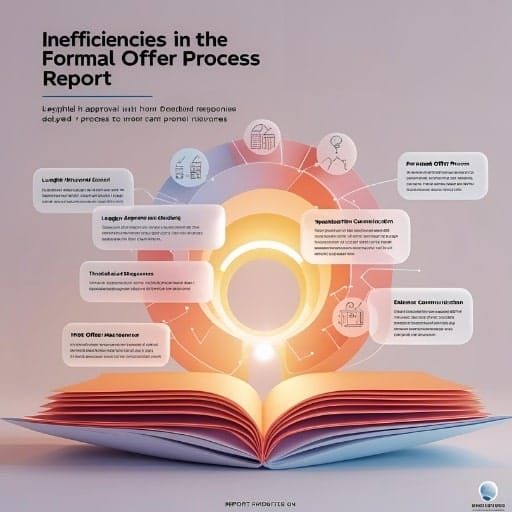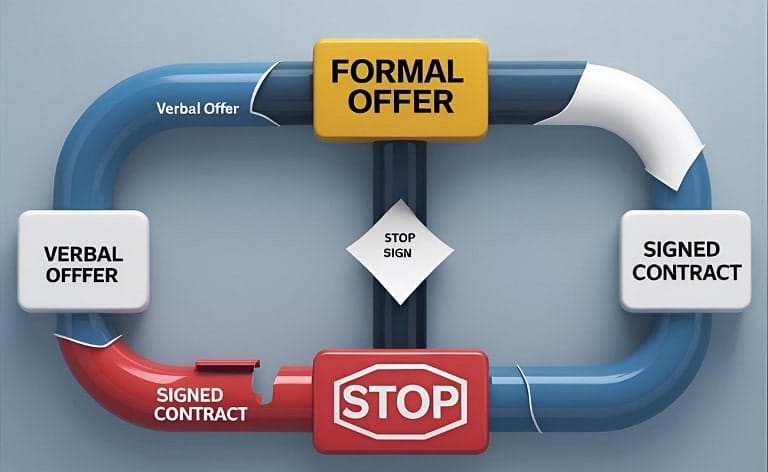Introduction: A Common Yet Costly Bottleneck in C-Level Hiring
In the world of executive recruitment, there’s nothing more frustrating than securing a “yes” to a verbal offer—only to watch the process stall or fall apart before the dotted line is signed. While the candidate seemed enthusiastic during negotiations, the enthusiasm fades, communication slows, and suddenly your top choice becomes unavailable.
This pattern is more than a hiring hiccup—it’s a red flag. At JRG Partners, we’ve seen how failing to convert verbal executive offers to signed contracts can undermine leadership planning, delay innovation initiatives, and damage employer branding.
In this article, we explore the five key breakdown points and how to fix them.
Pro Tip: A verbal offer falling through often points to a lack of deep alignment, something our headhunting services for executives work to solidify long before the offer stage.
1. Lack of Momentum After the “Yes”
One of the most overlooked issues in executive hiring is the engagement gap that follows a verbal offer. Too many companies assume that once the candidate says “yes,” their job is done—when in fact, the most delicate phase is just beginning.
To avoid this:
- Assign an executive sponsor or peer to reach out personally within 24 hours of the verbal offer
- Share relevant company content—strategic vision decks, leadership videos, cultural highlights
- Keep the communication loop active until the formal offer is signed
Post-verbal offer executive engagement strategies help reinforce the emotional commitment behind the initial “yes.”
2. Failure to Spot Underlying Hesitations
C-suite candidates are masters of polished communication—but even the most poised executive may harbor doubts. If you’re not tuned into body language, delayed responses, or vague enthusiasm, you could be missing critical red flags in offer acceptance.
Watch for:
- Reluctance to commit to a signing timeline
- Requests for “more time to think” even after a verbal acceptance
- Increased references to current employer loyalty or family considerations
Identifying red flags in C-suite offer acceptance gives you a chance to intervene before momentum is lost.
3. Inefficiencies in the Formal Offer Process

Many companies lose top talent not because the candidate changed their mind—but because the offer letter took too long to arrive. A delayed or overly complex offer process introduces friction, and friction leads to drop-off.
Best practices for streamlining executive offer letter processes:
- Prepare legal and HR teams before the verbal offer is made
- Pre-approve all compensation elements, including bonuses and equity, in advance
- Use clear, concise language—avoid unnecessary legalese unless required
Speed signals confidence. Slowness signals indecision.
4. Candidates Using Your Offer as Leverage
In today’s competitive market, some executives entertain offers not with intent to leave, but to negotiate better terms with their current employer. This isn’t personal—it’s strategic. But it leads to a surge of managing candidate cold feet after executive verbal offer acceptance.
To manage this:
- Ask early: “Is there anything your current employer could do to keep you from making this move?”
- Include retention-risk questions during reference checks
- Follow up within 48 hours of the verbal “yes” to reaffirm intent and timeline
By being proactive, you can reduce your exposure to opportunistic behavior.
5. Lack of Structured Verbal Offer Protocol
Too many organizations treat the verbal offer like a handshake deal—but today’s executive hires require a formalized verbal offer protocol that bridges the gap to contract.
To improve your converting verbal executive offers to signed contracts process:
- Deliver the verbal offer from a high-ranking stakeholder (CEO, Board member, etc.)
- Outline next steps clearly during the call, including expected signing timeline
- Follow up immediately with a calendar invite for a formal offer review session
A well-structured verbal offer is not casual—it’s strategic. It sets the tone for how seriously your organization treats the hire.
Verbal offers that fall apart often do so because of compensation, a sign that the compensation you offered your lead candidate was rejected as non-competitive.
Conclusion: From “We’re Excited” to “We’re Signed”
Losing an executive candidate after a verbal offer isn’t just inconvenient—it’s expensive. It delays transformation, weakens succession planning, and can impact morale internally. But with the right communication, speed, and structure, you can move from verbal acceptance to written contract with confidence.
At JRG Partners, we help companies optimize their executive recruitment pipeline—from outreach to signed offer—by eliminating the friction points that often derail closing. If your verbal offers aren’t sticking, the problem isn’t the candidate. It’s the process.
With the right approach, every “yes” can become a “signed and onboarded.” Learn how JRG Partners can optimize your executive offer process.


